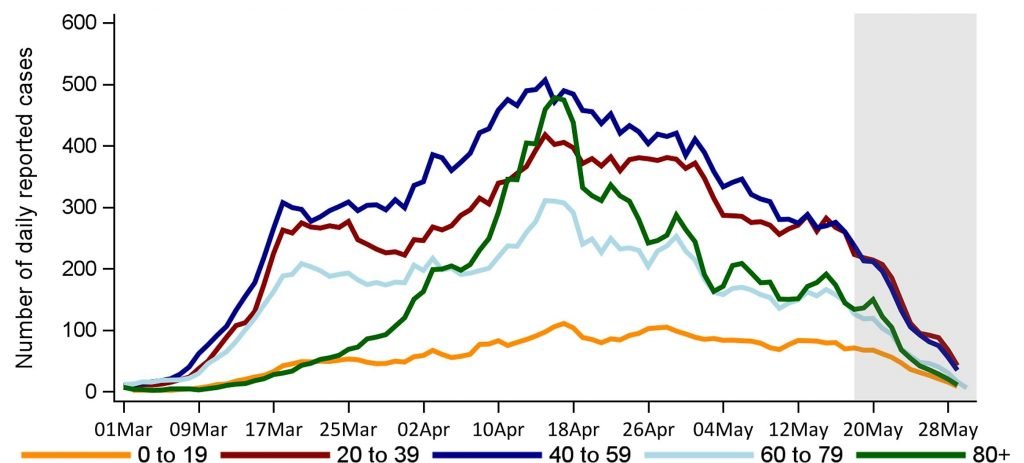
Dimitris Ilias
After a long period of toil, anxiety and hardship, Canadians are got their first good news. The official EPI and modeling update from Health Canada finally shows that the epidemic growth has slowed across all age groups.
Age groups affected
All age groups have been affected although the number of cases among children and youth has remained low. Young and middle age adults account for the majority of cases early on and through to the present. The sharp peak of cases aged 80 years and older is in large part due to outbreaks in long-term care homes in Quebec and Ontario. A recent peak in the cases from Ontario was later attributed to tests results being delivered with a delay that showed the next day as an increase when in reality, Ontario shows the lowest numbers since March.
Core public health measures
As provinces are beginning to reopen Canadian society, data and modelling indicate that core public health measures remain essential to control the epidemic in Canada. The Canadian public health agency is advising physical distancing amongst individuals as the number one measure citizens can take to combat the spread. The other measures remain detection and isolation of cases, tracing and quarantining contacts and finally managing the risk of importation.
The stats
Out of the total of covid-19 cases in Canada 8% ended in death, 16% needed hospitalization and 3% entered the ICU. Older Canadians are still the age group that is most in danger from the new virus. Based on available data, people aged over 60 years comprise the 94% of the 7,495 deaths (As of June 4th), the 71% of 8,742 hospital admissions and the 61% of the 1,721 ICU admissions. 82% of 7,495 deaths are linked to long-term care and seniors’ homes. Quebec and Ontario account for over 90% of the national case count over the past 14 days. No community transmission in Prince Edward Island, the Northwest Territories or the Yukon. There have been no cases reported to date in Nunavut.
Where the virus thrived
Once more the Canadian report shines the light at the devastation in long term care for seniors’ homes as cases represent 18% of cases and 82% of deaths country wide. Outbreaks in other settings where people congregate whether at home or work are also continuing to drive case counts. Canada’s largest outbreak occurred at the Cargill meat processing plant in Alberta with 1,560 cases among workers, household and community members. Movement of workers, whether between workplaces or across jurisdictions, has initiated new chains of transmission, for example: Health care workers working at more than one facility and an outbreak in northern Saskatchewan linked to a worker camp in Alberta.
Take a look at the
featured Local Savings
at the bottom of this page!
That “all important” Rt value
Rt is a very important measurement used by epidemiologists to track how fast a virus spreads.It is the time variable reproduction rate, representing the average number of new infected people for each infected person. At the beginning of the pandemic in Canada that value was 2, meaning one infected person was infecting 2 more. The latest graph from the 4th of June report shows how the Rt has remained below 1 for nearly 2 weeks suggesting that public health measures are being effective in controlling the epidemic. Fluctuations above and below 1 in the last month reflect ongoing transmission in some communities and settings across the country, especially in and around Canada’s most populous cities, Toronto and Montreal.
Modelling as our crystal ball
One of the most important tools that health Canada has to predict the future spread of the virus is modelling. In the most recent report, scientists and statisticians created 3 distinct scenarios:
The first scenario is the one where no measures would be taken by the government in which case the infection would result to 70%-80% Canadians infected
The second scenario would be the one with weaker controls (delay and reduce the peak). Low degree of physical distancing and low percentages of cases and their contacts traced and isolated or quarantined. That scenario predicts 25% to 50% infected.
The third scenario would feature stronger epidemic control with a high degree of physical distancing. A high percentage of cases and their contacts would be traced and isolated or quarantined leading to a small 1% to 10% of people infected.
Canada flattened the curve sooner than a number of countries such as the UK, Italy and US. Other countries such as South Korea and Japan demonstrated strong epidemic control to keep their curves smaller overall.















